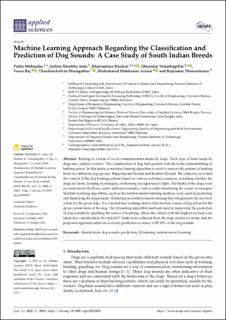| dc.contributor.author | Mohandas, Prabu | |
| dc.contributor.author | Anni, Jerline Sheebha | |
| dc.contributor.author | Hasikin, Khairunnisa | |
| dc.contributor.author | Velauthapillai, Dhayalan | |
| dc.contributor.author | Raj, Veena | |
| dc.contributor.author | Murugathas, Thanihaichelvan | |
| dc.contributor.author | Azizan, Muhammad Mokhzaini | |
| dc.contributor.author | Thanasekaran, Rajkumar | |
| dc.date.accessioned | 2023-03-23T12:23:35Z | |
| dc.date.available | 2023-03-23T12:23:35Z | |
| dc.date.created | 2022-11-28T14:38:10Z | |
| dc.date.issued | 2022 | |
| dc.identifier.citation | Applied Sciences. 2022, 12 (20), . | en_US |
| dc.identifier.issn | 2076-3417 | |
| dc.identifier.uri | https://hdl.handle.net/11250/3060117 | |
| dc.description.abstract | Barking is a form of vocal communication made by dogs. Each type of bark made by dogs has a distinct context. The classification of dog bark pattern will aid in the understanding of barking action. In this study, a machine learning algorithm is used to analyze the pattern of barking from two different dog species: Rajapalayam Hound and Kombai Hound. The objective is to find the context of the dog barking pattern based on various real-time scenarios, including whether the dogs are alone, looking at strangers, or showing an eagerness to fight. The barks of the dogs were recorded inside the house under different scenarios, such as while identifying the owner or strangers. Machine learning algorithms, such as the reinforcement learning method, were used in predicting and classifying the dog sounds. Q-learning is a reinforcement learning that will generate the next best action for the given state. It is a model-free learning used to find the best course of dog action for the given current state of the dog. The Q-learning algorithm had been used in improving the prediction of dog sounds by updating the values of learning, where the values with the highest reward were taken into consideration. In total, 6171 barks were collected from the dogs chosen for study, and the proposed approach achieved a correct prediction accuracy of 85.19% of the dog sounds.
Keywords: classification; dog sounds; prediction; Q-learning; reinforcement learning | en_US |
| dc.language.iso | eng | en_US |
| dc.publisher | MDPI | en_US |
| dc.rights | Navngivelse 4.0 Internasjonal | * |
| dc.rights.uri | http://creativecommons.org/licenses/by/4.0/deed.no | * |
| dc.title | Machine Learning Approach Regarding the Classification and Prediction of Dog Sounds: A Case Study of South Indian Breeds | en_US |
| dc.type | Peer reviewed | en_US |
| dc.type | Journal article | en_US |
| dc.description.version | publishedVersion | en_US |
| dc.rights.holder | © 2022 by the authors | en_US |
| dc.source.pagenumber | 0 | en_US |
| dc.source.volume | 12 | en_US |
| dc.source.journal | Applied Sciences | en_US |
| dc.source.issue | 20 | en_US |
| dc.identifier.doi | 10.3390/app122010653 | |
| dc.identifier.cristin | 2106101 | |
| dc.source.articlenumber | 10653 | en_US |
| cristin.ispublished | true | |
| cristin.fulltext | original | |
| cristin.qualitycode | 1 | |

